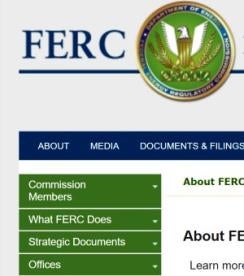Ninth Circuit Denies Challenge to FERC’s Eagle Mountain Project Decision
In a July 28, 2021 panel decision, the U.S. Court of Appeals for the Ninth Circuit denied a challenge by an environmental organization to FERC’s grant of an extension to commence construction of the Eagle Mountain Pumped Storage Hydroelectric Project. The licensee sought a retroactive extension of the commencement deadline pursuant to the 2018 America’s Water Infrastructure Act (AWIA), which amended section 13 of the Federal Power Act (FPA) to authorize FERC to issue any number of extensions of the commencement date for a project up to a total of eight years. The environmental organization attempted to intervene in opposition to the extension and claimed FERC should have issued public notice as required by FPA section 6 for license amendments. It also argued that FERC was not authorized by Congress to issue a retroactive extension of the commencement deadline. FERC denied the intervention based on its long-established precedent that interventions in post-license proceedings are only permitted where the licensee proposes a material change in the project plans, or where the filings could adversely affect the rights of property holders in a manner not contemplated in the license. FERC also rejected the argument it was required by section 6 to issue public notice of an extension of time request.
The court upheld FERC’s application of its intervention rules to bar interventions in post-license proceedings with only limited exceptions, finding that FERC should have the flexibility to manage its own dockets and that allowing interventions in response to extensions of time would be administratively inefficient and allow relitigation of issues already decided at licensing. The court also held that FERC’s interpretation that an extension of time is not an alteration of license under FPA section 6 triggering public notice and intervention was reasonable. Finally, because the environmental organization was not a party before FERC, the court found that it lacked jurisdiction to reach the merits of whether FERC was authorized to issue a retroactive extension of the commencement of construction deadline under the AWIA.
Kuster Introduces Twenty-First Century Dams Act
On July 9, Representative Annie Kuster (D-NH) introduced the bipartisan Twenty-First Century Dams Act in the House of Representatives, H.R. 4375. The bill proposes to invest $25.8 million dollars to rehabilitate, retrofit, and remove more than 90,000 dams, including a small percentage of dams that are considered “high hazard” and have poor, unsatisfactory, or unknown safety ratings. The Act will:
-
Improve dam safety by increasing federal assistance to carry out a national program of inspection of dams. Any non-federal dams not under a regulatory inspection authority will be inspected by the Secretary of the Army acting through the U.S. Army Corps of Engineers (Corps). The bill proposes to create a priority system for high hazard dams and provide funds for rehabilitating of these dams.
-
Create a tax credit of 30 percent for any taxable year for maintaining and enhancing hydroelectric dams. The qualifying expenditures would include improvements to dam safety, environmental, and grid resilience enhancement property. The improvements must be authorized under applicable federal, state, and Tribal permitting or licensing processes that take into consideration appropriate mitigation conditions from consultation and environmental review. There is also a 30 percent tax credit for dam removals if the dam is considered an “obsolete river obstruction.” These dams are qualified nonpowered dams or non-federal dams.
-
Establish an interagency advisory council, a Tribal and stakeholder advisory board, and provide funding to remove qualifying dams. The purpose of this advisory committee is to restore river ecosystems by helping to administer a public source of climate resilience and conservation funding to reconnect 10,000 miles of rivers through the removal of 1,000 dams with owner consent.
Senator Dianne Feinstein (D-Cal.) introduced the Act’s companion bill, S. 2356, in the Senate on July 15.
First Circuit Reaffirms that Penobscot River Falls Outside Tribal Jurisdiction
In Penobscot Nation v. Frey, the U.S. Court of Appeals for the First Circuit (First Circuit) again ruled that the Penobscot River falls outside the boundaries of the Penobscot Indian Reservation, affirming a 2017 decision of a divided First Circuit panel that handed a loss to the Tribe’s decade-long fight for authority over a segment of the Penobscot River.
The case goes back to 2012, when the Penobscot Nation sued the State of Maine, asserting its jurisdiction over a roughly 60-mile stretch of the river located close to the Tribe’s reservation land. The Tribe stated it had control over fishing, hunting, and other activities in the river. In its original complaint, the Penobscot Nation argued that when it entered into an agreement with Maine to settle its land claims in the State, “the Nation never intended to relinquish its ownership rights” to the 60-mile Main Stem of the river, and that Congress intended “that the Nation’s reservation encompass ownership rights within and attending” that segment of the river. A group of 18 private parties bordering the River or using it for discharges or other purposes intervened in support of the State of Maine. Among them were Kruger Energy USA, which develops hydroelectric, wind, and solar power plants across the country; waste management company Coventa Maine, LLC; as well as various towns, municipalities, and districts. The United States government intervened in support of the Penobscot Nation.
In 2017, a divided First Circuit panel ruled that the Penosbcot Nation had sustenance fishing rights within the river and authority over islands within it, but the river itself falls outside of the Penobscot Indian Reservation under multiple statutes. The Penobscot Nation and the federal government successfully petitioned the court to vacate the 2017 decision and grant an “en banc” review, which resulted in the recent 3-2 decision.
Writing for the majority, Circuit Judge Sandra Lynch stated that “the Reservation does not include the waters and submerged lands constituting the riverbed of the Main Stem [of the Penosbcot River].” Judge Lynch referred to multiple statutes stating that the Penobscot reservation “plainly and unambiguously” includes “solely . . . Indian Island . . . and all islands in [the River] northward thereof,” but does not include the river itself. Citing the recent U.S. Supreme Court decision involving the boundaries of an Indian reservation, McGirt v. Oklahoma, the court stressed that “reliance on legislative history is only appropriate when a statute is ambiguous,” which is not the case here. Judge Lynch added that “context, history, and clear legislative intent” militate against the Tribe’s claim.
As for the Tribe’s sustenance fishing rights, the court wrote that this does not alter the clear definition of the Reservation. This claim also lacks standing, the court wrote, because such rights have not yet been infringed upon by the State of Maine.
Denver Water Files Suit over County Attempts to Delay the Gross Reservoir Project Expansion
On July 14, 2021, the City and County of Denver, through its Board of Water Commissioners (“Denver Water”) filed a lawsuit against Boulder County and its board of commissioners in Colorado, arguing that FERC’s complete authority over licensing of a hydropower project under the Federal Power Act preempts Boulder County’s authority. Denver Water asserts in the complaint that Boulder County is using its local land use permitting process to obstruct a $464 million hydropower dam expansion for Gross Reservoir. Further, Denver Water argues that Boulder County cannot delay or deny approvals based on its local permitting process due to federal preemption, and accordingly seeks an injunction to bar Boulder County from making any further attempts to use local land use authority to interfere with the project. Denver Water argues that FERC already provided the utility with permission to proceed with the expansion—but that permission requires construction begin within two years and be completed by July 2027. Denver Water filed the complaint in Colorado federal court, Case Number 1:21-cv-01907.
FERC Clarifies Standard for Granting of Temporary Amendment
Holding that a “temporary amendment may be granted to allow for greater flexibility or to reduce adverse effects during a specific event of finite duration, not as a tool to avoid compliance,” FERC has denied Northern States Power’s request to extend a variance to its reservoir operating plan to allow higher reservoir levels. In a July 15, 2021 order, the Commission held that an extension of the temporary amendment pending relicensing could result in a temporary amendment of 10 years or more, which is more akin to a permanent amendment and that such a change had not been properly analyzed for environmental effects. The Commission ruled that the licensee must immediately comply with its license reservoir elevation limits and report any variances to the Commission.
Federal District Court Grants EPA’s Motion for Voluntary Remand
On July 14, 2021, the U.S. District Court for the District of South Carolina allowed the Trump Waters of the United States (WOTUS) rule to remain in place while the U.S. Environmental Protection Agency (EPA) and the Corps work on a replacement rule. The litigation stems from President Trump’s Navigable Waters Protection Rule (or the WOTUS rule), which significantly narrowed which waterways qualify for federal protection under the Clean Water Act. The Biden administration asked courts to remand the Trump-era rule to EPA while the EPA writes a new rule. Notably, the Biden administration asked courts not to throw out the Trump-era rule entirely while the new rule is being drafted. Environmental groups criticized keeping the Trump-era rule in place and raised concerns about how long it will take the Biden administration to issue a new rule. Accordingly, environmental groups across the country sued in federal court, including in this South Carolina court, asking courts to immediately remove the Trump-era WOTUS rule. This South Carolina court sided with the Biden administration in a short order with no explanation, refusing to throw out the Trump-era rule and dismissing Case No. 2:20-cv-01687-BHH.
FERC Final Rule Amends Profile Drawing Requirement for Qualifying Conduit Notices of Intent
FERC issued a final rule on July 15 revising the Commission’s regulations at 18 C.F.R. parts 4 and 5 governing the filing requirements for qualifying conduits and certain major hydroelectric power projects. The final rule extends the licensing and amendment filing requirements that currently apply to major projects up to 5 MW to major projects 10 MW or less, consistent with the definition of small hydroelectric power project in the Hydropower Regulatory Efficiency Act of 2013. Additionally, the Commission is removing the requirement that a notice of intent to construct a qualifying conduit include a profile drawing showing the source of the hydroelectric potential in instances where a dam would be constructed in association with the facility. The revisions in the final rule effectively align the filing requirements for qualifying conduit with major projects up to up to 5 MW to major projects 10 MW or less and slightly reduces the reporting requirements. This rule will become effective 60 days after the date of publication in the Federal Register.






 i
i

